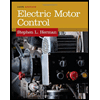
Concept explainers
Explain the reason for the idle winding to remain open circuited in the running condition of a four speed, two winding motor.
Explanation of Solution
Refer to Figure 33-2 in the Textbook, which illustrates the common motor connections of the four-speed, two winding motors with different speeds.
The idle winding of the motor remains to be open circuited in running state on given speeds. Through open circuiting, energizing windings can be prevented from imposing of unnecessary electrical loads. These loads can result from the transformer action which produces the circulating currents in the secondary, idle winding.
Conclusion:
Thus, the reason for the idle winding to remain open circuited in the running condition of a four speed, two winding motor is explained.
Want to see more full solutions like this?
Chapter 33 Solutions
Electric Motor Control
- Solve this problem and show all of the workarrow_forwardSolve this problem and show all of the workarrow_forwardA 3 km long multimode step index fibre operating at a bandwidth of 4 Mhz has a core refractive index of 1.48 and a refractive index difference of 1 %. Evaluate the rms pulse broadening per kilometer which results from chromatic dispersion.arrow_forward
- Find the Thevenin Equivalent of the circuit below, show all steps;arrow_forwardFind the Thevenin Equivalent Circuit of the following and find the current through R_L, show all steps;arrow_forwardFind the Thevenin Equivalent Circuit of the circuit below and the current through R_L , show all steps;arrow_forward
- Find the Norton Equivalent of the below and the voltage across R_L, show all steps;arrow_forwardUse Mesh Analysis to find the current through the laod resistor R_L. Show all steps;arrow_forwardFind Thevenin Equivalent of the circuit below and the current through the load resistor R_L. Show all steps;arrow_forward
- If = 5000 A actual time IDMT ---R,, Reand R3 The Tsm relays R, and R3 Draw The characteistic relays time margin between Tsm = 0.5 RCT=500/1 CS-125% TSM = 2 TSM = 0.2 and -0.6 R2 CTS = 500/1 Cs=100% Tsm=0.4 R3 CTS = 400/1 Cs=125% TSM = 2arrow_forwardLet X and Y be random variables having joint density function 01.5). (c) p(x) and p(y).arrow_forwardThe joint density function of two continuous random variables X and Y is: p(x, y) = {cxy 0 < x < 4,1 < y < 5 0 otherwise Find (i) the constant c (ii)P(1arrow_forwardarrow_back_iosSEE MORE QUESTIONSarrow_forward_ios

 Electricity for Refrigeration, Heating, and Air C...Mechanical EngineeringISBN:9781337399128Author:Russell E. SmithPublisher:Cengage Learning
Electricity for Refrigeration, Heating, and Air C...Mechanical EngineeringISBN:9781337399128Author:Russell E. SmithPublisher:Cengage Learning

